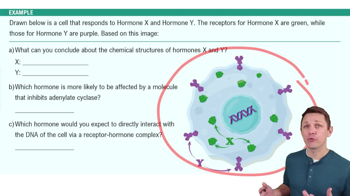Intracellular Receptors and Direct Gene Action definitions Flashcards
 Back
BackIntracellular Receptors and Direct Gene Action definitions
1/15
Terms in this set (15)
- Steroid HormonesLipid-soluble hormones that can pass through cell membranes to influence gene expression directly.
- Amino Acid-Based HormonesHormones that cannot penetrate cell membranes and rely on second messenger systems.
- Lipid SolubleCharacteristic of molecules that can dissolve in lipids, allowing them to pass through cell membranes.
- Receptor ProteinsProteins inside cells that bind to hormones to form a receptor-hormone complex.
- Receptor-Hormone ComplexA complex formed when a hormone binds to its receptor, capable of influencing gene expression.
- CytoplasmThe part of the cell where receptor proteins may bind with hormones before entering the nucleus.
- NucleusCell organelle where the receptor-hormone complex binds to DNA to affect gene expression.
- DNA RegionsSpecific areas of DNA where the receptor-hormone complex binds to influence gene expression.
- Gene ExpressionThe process by which information from a gene is used to synthesize RNA and proteins.
- Direct Gene ActionMechanism where hormones directly influence gene expression by binding to DNA.
- Second Messenger SystemsPathways used by amino acid-based hormones to transmit signals inside cells.
- TranscriptionThe process of copying a segment of DNA into RNA, initiated by the receptor-hormone complex.
- Protein SynthesisThe creation of proteins from RNA, a process influenced by steroid hormones.
- Transport ProteinProteins that bind to steroid hormones in the blood, aiding their transport to target cells.
- Physiological ChangeAlterations in body function or structure resulting from hormone-induced protein activity.


